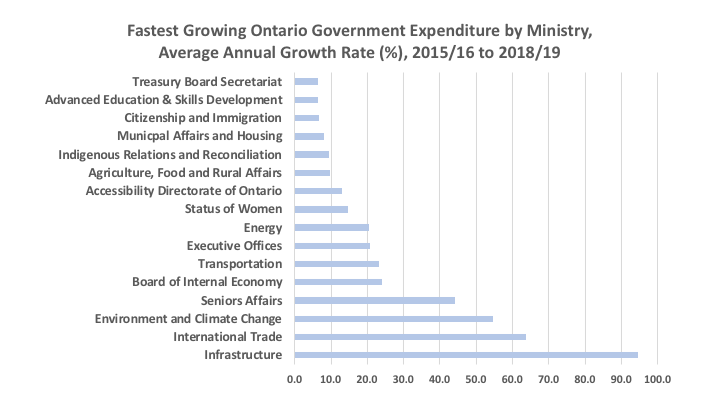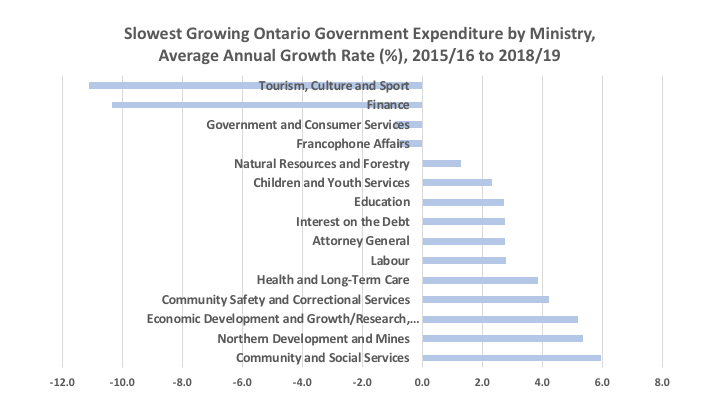Actually, including capital spending, Ontario’s deficit is more than $32 billion
Ontario’s 2018 provincial budget saw total operating expense reach $158.5 billion with total revenues at $152.5 billion, for a deficit of just over $6 billion. But there has been some debate over government accounting methods and the actual size of the deficit, with the most recent salvo from the provincial auditor general arguing that the deficit is actually $11.7 billion once Ontario Public Service Employees Union and Ontario Teachers’ Pension Plan assets are removed from the bottom line.
Of course, if you include this year’s capital spending, which is being added to the debt independently of the operating budget, you can add another $21.1 billion to spending bringing the deficit estimate up to $32.8 billion.
Along with the debate over the government’s accounting of pension assets and capital spending, it’s also interesting to examine where expenditure growth is occurring. What are the fastest and slowest growing expenditures by government department?
From 2015/16 to 2018/19, total operating expenditure grows from $139.7 billion to $158.5 billion for an average annual increase of 4.5 per cent. Across the 30 ministries listed, plus the interest on the debt in the 2018 Ontario budget, spending increases range from a high of 94.5 per cent for Infrastructure—which rises from $213 million in 2015/16 to $817 million in 2018/19—to a drop of 11 per cent for Tourism, Culture and Sport, which goes from $2.3 billion to $1.5 billion.
The charts below separate out the fastest and slowest growing ministries and plot the average annual growth rate of spending by ministry over fiscal years 2015/16 to 2018/19. Among the fastest-growing ministries are Infrastructure, International Trade, Environment and Climate Change, Seniors Affairs, and the Board of Internal Economy (which reviews, approves and governs the operations of the Office of the Legislative Assembly). Other fast-growing ministries include Transportation, Executive Offices, and Energy. And outside individual ministries, interest payments on the government’s debt are also one of the fastest-growing expense items.

For “slower” growing ministries, they range from a low of 1.3 per cent for Natural Resources and Forestry to a high of just under 6 per cent for Community and Social Services. Health over this period is growing at 3.9 per cent annually—just under the average for total operating expenditures at 4.5 per cent—while Education has also been growing well below the average at 2.7 per cent. The only government ministries to see a shrinking budget over this three-year period are Francophone Affairs (at an average annual rate of -0.8 per cent), Government and Consumer Services (-0.9 per cent), Finance (-10.4 per cent), and Tourism, Culture and Sport (11.1 per cent).

Given the precarious state and importance of Ontario’s public finances, it’s indeed curious that the provincial Ministry of Finance’s operating budget has dropped from $2.4 billion in 2015/16 to $1.7 billion in 2018/19. Much of this reduction comes from reduced power supply contract costs (from $875 million to $182 million), which is included in the ministry total along with the Ontario Municipal Partnership Fund. However, the base funding for Finance has indeed shrunk, from $1.048 billion to $986.2 million—a decline of nearly 2 per cent annually.
While this may simply represent a reallocation in functions and expertise away from Finance and into other ministries, it’s interesting in light of recent criticism of the province’s finances by the auditor general and the Financial Accountability Office. One hopes the reduction in the province’s base Ministry of Finance budget is not indicative of the priority placed on the province’s finances by the Wynne government.
On the other hand, perhaps Finance is leading by example and has been structuring its affairs more efficiently in a message of economy to other ministries. If so, based on the size of projected Ontario deficits over the next six years, the message seems to be falling on deaf ears.
Author:
Subscribe to the Fraser Institute
Get the latest news from the Fraser Institute on the latest research studies, news and events.

